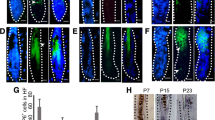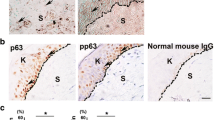Abstract
During the morphogenesis of hair follicles, the invasive migration of basal keratinocytes resembles cell’s dissemination of tissue remodeling. The urokinase-type plasminogen activator receptor (uPAR) appears to be a key molecule in the metastasis. In order to elucidate the relationship between uPAR and the invasion of the human hair follicle, immunohistochemistry, RT-PCR, plasmids transfection, and western blot were used. The results showed that uPAR was expressed in the outermost epithelial cells of the hair follicle and the basal keratinocytes of epidermis, and that the expression decreased with the development of the hair follicle. The cells of the outer root sheath (ORS) and interfollicle epidermis, which overexpressed uPAR, acquired increased invasiveness; however, they showed decreased invasion with overexpression of the urokinase-type plasminogen activator amino terminal fragment (uPA ATF), which inhibited the combination of uPAR and uPA competitively, and the cell invasive migration with overexpressed uPAR was required activated extracellular signal-regulated kinases (ERK). These results implied that overexpression of uPAR promote the invasive migration of hair follicle into the dermis in uPA-dependent and independent manner during human prenatal development.







Similar content being viewed by others
References
Aguirre Ghiso JA, Alonso DF, Farías EF, Gomez DE, de Kier Joffè EB (1999) Deregulation of the signaling pathways controlling urokinase production Its relationship with the invasive phenotype. Eur J Biochem 263:295–304. doi:10.1046/j.1432-1327.1999.00507.x
Akiyama M, Smith LT, Holbrook KA (1996) Growth factor and growth factor receptor localization in the hair follicle bulge and associated tissue in human fetus. J Invest Dermatol 106:391–396
Akiyama M, Smith LT, Shimizu H (2000) Changing patterns of localization of putative stem cells in developing human hair follicles. J Invest Dermatol 114:321–327. doi:10.1046/j.1523-1747.2000.00857.x
Andreasen PA, Egelund R, Petersen HH (2000) The plasminogen activation system in tumor growth, invasion, and metastasis. Cell Mol Life Sci 57:25–40
Bernard BA (2002) Hair biology: an update. Int J Cosmet Sci 24:13–16. doi:10.1046/j.0412-5463.2001.00109.x
Blasi F, Carmeliet P (2002) uPAR: a versatile signaling orchestrator. Nat Rev Mol Cell Biol 3:932–943. doi:10.1038/nrm977
Botchkarev VA, Paus R (2003) Molecular biology of hair morphogenesis: development and cycling. J Exp Zool B Mol Dev Evol 298:164–180. doi:10.1002/jez.b.33
Choong PF, Nadesapillai AP (2003) Urokinase plasminogen activator system: a multifunctional role in tumor progression and metastasis. Clin Orthop 415S:S46–S58. doi:10.1097/01.blo.0000093845.72468.bd
Commo S, Bernard BA (1997) The distribution of α2β1, α3β1 and α6β4 integrins identify as distinct subpopulations of basal keratinocytes in the outer root sheath of the human anagen hair follicle. Cell Mol Life Sci 53:466–471
Cotsarelis G (2006) Gene expression profiling gets to the root of human hair follicle stem cells. J Clin Invest 116:19–22. doi:10.1172/JCI27490
Croucher DR, Saunders DN, Lobov S, Ranson M (2008) Revisiting the biological roles of PAI2 (SERPINB2) in cancer. Nat Rev Cancer 8:535–545. doi:10.1038/nrc2400
Cui ZH, Yang T, Gao QG, Wang Y (2004) Urokinase plasminogen activator (uPA) is a positive regulator of outer root sheath keratinocyte proliferation. Cell Biol Int 28:571–575. doi:10.1016/j.cellbi.2004.04.012
D’Alessio S, Blasi F (2009) The urokinase receptor as an entertainer of signal transduction. Front Biosci 14:4575–4587
D’Alessio S, Gerasi L, Blasi F (2008) uPAR-deficient mouse keratinocytes fail to produce EGFR-dependent laminin-5, affecting migration in vivo and in vitro. J Cell Sci 121:3922–3932. doi:10.1242/jcs.037549
Dass K, Ahmad A, Azmi AS, Sarkar SH, Sarkar FH (2008) Evolving role of uPA/uPAR system in human cancers. Cancer Treat Rev 34:122–136. doi:10.1016/j.ctrv.2007.10.005
Duffy MJ (2004) The urokinase plasminogen activator system: role in malignancy. Curr Pharm Des 10:39–49
Ellis V, Scully M, Kakkar VV (1989) Plasminogen activation initiated by single chain urokinase-type plasminogen activator. Potentiation by U937 monocytes. J Biol Chem 264:2185–2188
Gu JM, Johns A, Morser J, Dole WP, Greaves DR, Deng GG (2005) Urokinase plasminogen activator receptor promotes macrophage infiltration into the vascular wall of ApoE deficient mice. J Cell Physiol 204:73–82. doi:10.1002/jcp.20262
Hildenbrand R, Gandhari M, Stroebel P, Marx A, Allgayer H, Arens N (2008) The urokinase-system—role of cell proliferation and apoptosis. Histol Histopathol 23:227–236
Holbrook KA, Smith LT, Kaplan ED, Minami SA, Hebert GP, Underwood RA (1993) Expression of morphogenesis during human follicle development in vivo and a model for studying follicle morphogenesis in vitro. J Invest Dermatol 101:39s–49s
Huang C, Jacobson K, Schaller MD (2004) MAP kinases and cell migration. J Cell Sci 117:4619–4628. doi:10.1242/jcs.01481
Jensen PJ, Lavker RM (1999) Urokinase is a positive regulator of epidermal proliferation in vivo. J Invest Dermatol 112:240–244. doi:10.1046/j.1523-1747.1999.00494.x
Kloepper JE, Hendrix S, Bodó E, Bodó E, Tiede S, Humphries MJ, Philpott MP, Fässler R, Paus R (2008) Functional role of beta 1 integrin-mediated signalling in the human hair follicle. Exp Cell Res 314:498–508. doi:10.1016/j.yexcr.2007.10.030
Lademann UA, Rømer MU (2008) Regulation of programmed cell death by plasminogen activator inhibitor type 1 (PAI-1). Thromb Haemost 100:1041–1046
Lavker RM, Risse B, Brown H, Ginsburg D, Pearson J, Baker MS, Jensen PJ (1998) Localization of plasminogen activator inhibitor type 2 (PAI-2) in hair and nail: implications for terminal differentiation. J Invest Dermatol 110:917–922. doi:10.1046/j.1523-1747.1998.00223.x
Li G, Yang T, Yan J (2002) Cyclooxygenase-2 increased the angiogenic and metastatic potential of tumor cells. Biochem Biophys Res Commun 299:886–890
Lund LR, Eriksen J, Ralfkiaer E, Rømer J (1996) Differential expression of urokinase-type plasminogen activator, its receptor, and inhibitors in mouse skin after exposure to a tumor-promoting phorbol ester. J Invest Dermatol 106:622–630
Luparello C, Del Rosso M (1996) In vitro anti-proliferative and anti-invasive role of aminoterminal fragment of urokinase-type plasminogen activator on 8701-BC breast cancer cells. Eur J Cancer 32A:702–707
Medcalf RL, Stasinopoulos SJ (2005) The undecided serpin. The ins and outs of plasminogen activator inhibitor type 2. FEBS J 272:4858–4867. doi: 10.1111/j.1742-4658.2005.04879.x
Mondino A, Blasi F (2004) uPA and uPAR in fibrinolysis, immunity and pathology. Trends Immunol 25:450–455. doi:10.1016/j.it.2004.06.004
Montuori N, Carriero MV, Salzano S, Rossi G, Ragno P (2002) The cleavage of the urokinase receptor regulates its multiple functions. J Biol Chem 277:46932–46939. doi:10.1074/jbc.M207494200
Morioka S, Lazarus GS, Baird JL, Jensen PJ (1987) Migrating keratinocytes express urokinase-type plasminogen activator. J Invest Dermatol 88:418–423
Oshima H, Rochat A, Kedzia C, Kobayashi K, Barrandon Y (2001) Morphogenesis and renewal of hair follicles from adult multipotent stem cells. Cell 104:233–245
Ossowski L, Aguirre-Ghiso JA (2000) Urokinase receptor and integrin partnership: coordination of signaling for cell adhesion, migration and growth. Curr Opin Cell Biol 12:613–620
Ploug M (2003) Structure-function relationships in the interaction between the urokinase-type plasminogen activator and its receptor. Curr Pharm Des 9:1499–1528
Ragno P (2006) The urokinase receptor: a ligand or a receptor? Story of a sociable molecule. Cell Mol Life Sci 63:1028–1037. doi:10.1007/s00018-005-5428-1
Rømer J, Lund LR, Eriksen J, Pyke C, Kristensen P, Danø K (1994) The receptor for urokinase-type plasminogen activator is expressed by keratinocytes at the leading edge during re-epithelialization of mouse skin wounds. J Invest Dermatol 102:519–522
Rømer J, Pyke C, Lund LR, Danø K (2001) Cancer cell expression of urokinase-type plasminogen activator receptor mRNA in squamous cell carcinomas of the skin. J Invest Dermatol 116:353–358. doi:10.1046/j.1523-1747.2001.01241.x
Satoh Y, Saitoh D, Takeuchi A, Ojima K, Kouzu K, Kawakami S, Ito M, Ishihara M, Sato S, Takishima K (2009) ERK2 dependent signaling contributes to wound healing after a partial-thickness burn. Biochem Biophys Res Commun 381:118–122. doi:10.1016/j.bbrc.2009.02.039
Schaefer BM, Stark HJ, Fusenig NE III, Todd RF, Kramer MD (1995) Differential expression of urokinase-type plasminogen activator (uPA), its receptor (uPA-R), and inhibitor type-2 (PAI-2) during differentiation of keratinocytes in an organotypic coculture system. Exp Cell Res 220:415–423
Schneider MR, Schmidt-Ullrich R, Paus R (2009) The hair follicle as a dynamic miniorgan. Curr Biol 19:R132–R142. doi:10.1016/j.cub.2008.12.005
Solberg H, Ploug M, Høyer-Hansen G, Nielsen BS, Lund LR (2001) The murine receptor for urokinase-type plasminogen activator is primarily expressed in tissues actively undergoing remodeling. J Histochem Cytochem 49:237–246
Song C, Lian XH, Yang T (2000) Biological aspects and progress of tPA/PAI-2 during differentiation of dermatic keratinocyte. Zhong Guo Ke Xue Ji Jin 14:147–150
Stenn KS, Paus R (2001) Controls of hair follicle cycling. Physiol Rev 81:449–494
Tang CH, Wei Y (2008) The urokinase receptor and integrins in cancer progression. Cell Mol Life Sci 65:1916–1932. doi:10.1007/s00018-008-7573-9
Tucker TA, Dean C, Komissarov A, Koenig K, Mazar A, Pendurthi U, Allen TC, Idell S (2009) The Urokinase Receptor Supports Tumorigenesis of Human Malignant Pleural Mesothelioma Cells. Am J Respir Cell Mol Biol Jul 27. [Epub ahead of print] doi: 10.1165/rcmb.2008-0433OC
Vassalli JD, Sappino AP, Belin D (1991) The plasminogen activator/plasmin system. J Clin Invest 88:1067–1072
Waltz DA, Fujita RM, Yang X, Natkin L, Zhuo S, Gerard CJ, Rosenberg S, Chapman HA (2000) Nonproteolytic role for the urokinase receptor in cellular migration in vivo. Am J Respir Cell Mol Biol 22:316–322
Watt FM (2002) Role of integrins in regulating epidermal adhesion, growth and differentiation. EMBO J 21:3919–3926. doi:10.1093/emboj/cdf399
Wei Y, Lukashev M, Simon DI, Bodary SC, Rosenberg S, Doyle MV, Chapman HA (1996) Regulation of integrin function by the urokinase receptor. Science 273:1551–1555
Wei Y, Yang X, Liu Q, Wilkins JA, Chapman HA (1999) A role for caveolin and the urokinase receptor in integrin-mediated adhesion and signaling. J Cell Biol 144:1285–1294
Xing RH, Rabbani SA (1996) Overexpression of urokinase receptor in breast cancer cells results in increased tumor invasion, growth and metastasis. Int J Cancer 67:423–429
Xue A, Xue M, Jackson C, Smith RC (2009) Suppression of urokinase plasminogen activator receptor inhibits proliferation and migration of pancreatic adenocarcinoma cells via regulation of ERK/p38 signaling. Int J Biochem Cell Biol 41:1731–1738. doi:10.1016/j.biocel.2009.03.004
Xue W, Mizukami I III, Todd RF, Petty HR (1997) Urokinase-type plasminogen activator receptors associate with beta1 and beta3 integrins of fibrosarcoma cells: dependence on extracellular matrix components. Cancer Res 57:1682–1689
Zhou HM, Nichols A, Meda P, Vassalli JD (2000) Urokinase-type plasminogen activator and its receptor synergize to promote pathogenic proteolysis. EMBO J 19:4817–4826. doi:10.1093/emboj/19.17.4817
Zhou HM, Nichols A, Wohlwend A, Bolon I, Vassalli JD (1999) Extracellular proteolysis alters tooth development in transgenic mice expressing urokinase-type plasminogen activator in the enamel organ. Development 126:903–912
Acknowledgments
This study was supported by the grants from the National Nature Science Foundation of China (No. 30471568) and the Scientific Research & Innovation Fund of the Third Military Medical University of China (XG 2006).
Conflict of interest statement
The authors state no conflict interest.
Author information
Authors and Affiliations
Corresponding author
Additional information
Q. Gao, G. Fu and G. Huang contributed equally to this work.
Rights and permissions
About this article
Cite this article
Gao, Q., Fu, G., Huang, G. et al. Relationship between urokinase plasminogen activator receptor (uPAR) and the invasion of human prenatal hair follicle. Arch Dermatol Res 302, 409–418 (2010). https://doi.org/10.1007/s00403-009-1010-2
Received:
Revised:
Accepted:
Published:
Issue Date:
DOI: https://doi.org/10.1007/s00403-009-1010-2




